Header Image from National Park Service Cuyahoga Valley National Park, Ohio.
Ohio was admitted on March 1, 1803 as the 17th state.
Ohio became a state on March 1, 1803, although no formal declaration was made until 1953, when President Dwight Eisenhower officially signed the documents making it a state, retroactive to the original date.
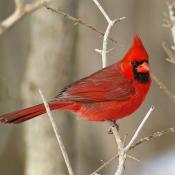 Bird: Cardinal Also called the Northern Cardinal or the Ohio Cardinal. Unlike many other songbirds in North America, both the male and female cardinals can sing. Usually, only a male songbird is capable of singing. When a female cardinal sings from the nest, it usually means she’s telling the male she needs more food. Cardinals mate for life. A group of cardinals has many collective nouns, including a “college”, “conclave”, “deck”, “radiance”, and “Vatican” of cardinals.
Bird: Cardinal Also called the Northern Cardinal or the Ohio Cardinal. Unlike many other songbirds in North America, both the male and female cardinals can sing. Usually, only a male songbird is capable of singing. When a female cardinal sings from the nest, it usually means she’s telling the male she needs more food. Cardinals mate for life. A group of cardinals has many collective nouns, including a “college”, “conclave”, “deck”, “radiance”, and “Vatican” of cardinals.
The cardinal is the mascot of prominent sports teams and schools, including the St. Louis Cardinals and Arizona Cardinals; it is the state bird of seven states, more than any other bird: Illinois, Indiana, Kentucky, North Carolina, Ohio, Virginia, West Virginia
 Flower: Scarlet Carnation It was well-known that William McKinley, the 25th president, liked to keep a red carnation in his lapel—in fact, he gave one away to a little girl just minutes before he was shot in 1901. To honor the assassinated president, Ohio voted to make McKinley’s iconic scarlet carnation the official state flower.
Flower: Scarlet Carnation It was well-known that William McKinley, the 25th president, liked to keep a red carnation in his lapel—in fact, he gave one away to a little girl just minutes before he was shot in 1901. To honor the assassinated president, Ohio voted to make McKinley’s iconic scarlet carnation the official state flower.
 Tree: Buckeye tree The state of Ohio is chock-full of Aesculus trees, a genus that grows very large seed nuts.
Tree: Buckeye tree The state of Ohio is chock-full of Aesculus trees, a genus that grows very large seed nuts.
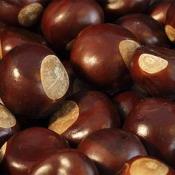 Nickname: Buckeye State Native Americans noticed that the nuts resembled the brown, large shape of deer eyes, which is why Ohio is now known as the Buckeye State. Native Americans would blanch buckeye nuts, extracting the tannic acid for use in making leather. The nuts can also be dried, turning dark as they harden with exposure to the air, and strung into necklaces similar to those made from the kukui nut in Hawaii.
Nickname: Buckeye State Native Americans noticed that the nuts resembled the brown, large shape of deer eyes, which is why Ohio is now known as the Buckeye State. Native Americans would blanch buckeye nuts, extracting the tannic acid for use in making leather. The nuts can also be dried, turning dark as they harden with exposure to the air, and strung into necklaces similar to those made from the kukui nut in Hawaii.
State Quarter
From theus50.com
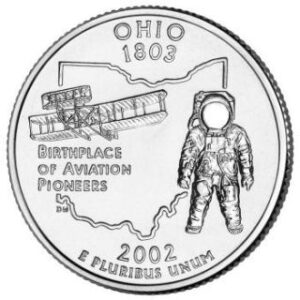
The Ohio quarter honors the state’s contribution to the history of aviation, depicting an early aircraft and an astronaut, superimposed as a group on the outline of the state. The design also includes the inscription “Birthplace of Aviation Pioneers”.
The claim to this inscription is well justified, the history making astronauts Neil Armstrong and John Glenn were both born in Ohio, as was Orville Wright, co-inventor of the airplane. Orville and his brother, Wilbur Wright, also built and tested one of their early aircraft, the 1905 Flyer III, in Ohio.
Capital: Columbus, Ohio
Motto: With God all things are possible
The state takes its name from the Ohio River. A common translation, “beautiful river,” originates in a French traveler’s 1750 account of visiting the region. He referred to the Ohio River as “une belle riviere” and gave its local Indian name as Ohio from the Iroquois word ohi-yo’, which means “great river.”
Ohio Facts and Trivia
The first European to arrive in Ohio was French explorer Robert de La Salle in 1669. He claimed the land for the French. Soon the French had established trading posts in order to capitalize on the valuable fur trade in the region. They built several forts including Fort Miami in 1680 and Fort Sandusky in 1750.
Initially colonized by French fur traders, Ohio became a British colonial possession following the French and Indian War in 1754.
At the end of the American Revolution, Britain ceded control of the territory to the newly formed United States, which incorporated it into the Northwest Territory.
Marietta was Ohio’s first permanent settlement. Founded in 1788 by General Rufus Putnam and named in honor of Marie Antoinette, then queen of France.
1837 – The Proctor & Gamble Company was established in Cincinnati.
In 1852 Ohio was the first state to enact laws protecting working women.
John Mercer Langston is believed to have been the first African American elected to public office. He was elected clerk of Brownhelm in 1854.
The first ambulance service was established in Cincinnati in 1865.
John Lambert of Ohio City made America’s first automobile in 1891.
The first full time automobile service station was opened in 1899 in Ohio.
Ohio gave America its first hot dog in 1900. Harry M. Stevens created the popular dining dog.
Charles Kettering of Loundonville invented the automobile self-starter in 1911.
Roy J. Plunkett of New Carlisle invented Teflon in 1938.
Ohio is sometimes called the “Mother of Modern Presidents,” having sent seven Ohioans (both natives and residents) to the White House since 1869. They are: Ulysses S. Grant, Rutherford B. Hayes, James A. Garfield, Benjamin Harrison, William McKinley, William H. Taft, and Warren G. Harding.
William Henry Harrison was born in Virginia but settled in Ohio as the first governor of the Northwest Territory.
Ohio is also known as the home of the Rock and Roll Hall of Fame in Cleveland and National Football League Hall of Fame in Canton.
Ohio is the leading producer of greenhouse and nursery plants.
Ohio has the nation’s 10th largest highway network and is within a one-day drive of 50% of North America’s population.
Ohio’s state flag is a pennant design. It is the only state flag of that design in the United States.
Cities
Akron is the rubber capital of the world.
Chillicothe was Ohio’s first capital city.
Cincinnati Red Stockings were the first professional baseball team.
The city of Cleveland was founded by Connecticut-born Moses Cleaveland, who, in 1796, went to survey land claimed by the Connecticut Land Co. as part of the Western Reserve. Although the city was originally named “Cleaveland,” in the early 1930s the Cleveland Advertiser dropped the “a” in order to fit the name on its masthead, and the new spelling caught on.
The Cuyahoga River has caught fire at least 13 times and is therefore nicknamed “The River That Caught Fire.” It was one of the most polluted rivers in the country and would easily catch fire when sparks from the train would fall into the water. Only after elaborate media coverage, it was cleaned up in 1969.
East Liverpool was the beginning point of the United States Public Land Survey. The location was the area from which a rectangular-grid land survey system was established under the Ordinance of 1785. The survey provided for administration and subdivision of land in the Old Northwest Territory. The Ordinance stipulated that all public lands were to be divided into townships six miles square.
The Y Bridge in Zanesville was first built in 1814 to span the confluence of the Licking and Muskingum Rivers. The current bridge is the fifth construction at the same location. “Ripley’s Believe It or Not” proclaimed it the only bridge in the world which you can cross and still be on the same side of the river.
Weird Laws:
Fishing for Whales on Sunday is illegal. You can’t get a fish drunk. Women are not allowed to wear patent leather shoes in public, and it is illegal for more than five women to live in a house. Lastly, even after breaking the laws as mentioned above, you can’t be arrested on Sunday or on the Fourth of July.
The Ohio driver’s education manual states that you must honk the horn whenever you pass another car.
Posting signs at swimming pools is illegal in Akron.
It is also illegal in Akron to display colored chickens for sale.
It is illegal to walk a cow down Lake Road in Bay Village.
The installation and usage of slot machines in outhouses is prohibited in Bexley.
If someone loses their pet tiger, they must notify the authorities within one hour.
In Cleveland, it is illegal to catch mice without a hunting license.
Columbus: It’s illegal for stores to sell Corn Flakes on Sunday.
People:
-
- Neil Alden Armstrong, astronaut
- Ambrose Bierce, journalist
- Erma Bombeck, columnist, humorist
- Bill Boyd / Hopalong Cassidy, actor
- William Jennings Bryan, U.S. presidential candidate
- Clarence Crane, inventor. After seeing a pill-making machine quickly pop out pellets, Ohio candymaker Clarence Crane realized he could make mints with it the same way. The machine happened to have a defect that punched a hole in the middle of the round, but Crane capitalized on that fact by naming his new mints “Life Savers.” He sold his invention for just $2900 in 1913.
- George Armstrong Custer, army officer
- Dorothy Dandridge, actress
- Doris Day, singer, actress
- Clarence Seward Darrow, lawyer
- Ruby Dee, actress
- Hugh Downs, TV broadcaster
- Paul Laurence Dunbar of Dayton is known as the poet laureate of African Americans.
- Thomas Alva Edison, inventor
Thomas A. Edison from Milan developed the incandescent light bulb, phonograph, and early motion picture camera. - Ermal Fraze invented the pop-top can in Kettering.
- Clark Gable, actor
-
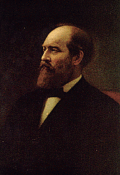 James Abram Garfield, U.S. president
James Abram Garfield, U.S. president
- Lillian Gish, actress
- John Herschel Glenn, astronaut, senator
Ohio senator John Glenn became the oldest man to venture into outer space.On February 20, 1962 he was the first American to orbit the earth. In October of 1998 at age 77 he returned to the space program and traveled back into space. - Charles Goodyear of Akron developed the process of vulcanizing rubber in 1839.
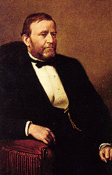 Ulysses Simpson Grant, U.S. president
Ulysses Simpson Grant, U.S. president- Zane Grey, author
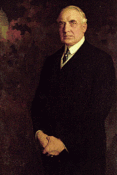 Warren Gamaliel Harding, U.S. president
Warren Gamaliel Harding, U.S. president- Arsenio Hall, television personality
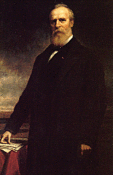 Rutherford Hayes, U.S. president
Rutherford Hayes, U.S. president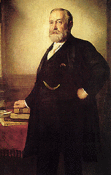 Benjamin Harrison, U.S. president
Benjamin Harrison, U.S. president- DeHart Hubbard, long jumper, was the first African American to earn an Olympic Gold Medal. The award occurred during the 1924 Olympics games held in Paris. He set the record for long jumping.
- Dean Martin, singer, actor
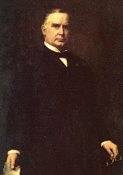 William McKinley, U.S. president
William McKinley, U.S. president- Paul Newman, actor
- Jack Nicklaus, golfer
- Annie Oakley, markswoman
- Jesse Owens, track and field athlete, won four gold medals in the 1936 Olympics in Berlin.
- Norman Vincent Peale, clergyman
- Tyrone Power, actor
- Judith Resnik, astronaut
- Eddie Rickenbacker, aviator
- James J. Ritty, of Dayton, invented the cash register in 1879.
- Arthur M. Schlesinger, Jr, historian
- W.F. Semple of Mount Vernon patented chewing gum in 1869.
- William Tecumseh Sherman, army general
- Steven Spielberg, director, screenwriter
- Gloria Steinem, feminist
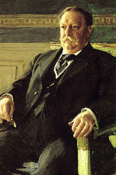 William H. Taft, U.S. president
William H. Taft, U.S. president- Ted Turner, broadcasting
- Lowell Thomas, commentator, author
- James Thurber, author, cartoonist
- Orville Wright, inventor
- Cy Young, baseball player
Credits
See Ducksters.com
***Nelson, Ken. “Ohio State History for Kids.” Ducksters, Technological Solutions, Inc. (TSI), www.ducksters.com/geography/us_states/ohio_history.php. Accessed 17 February 2019.
See Oh Fact.com
See Mental Floss.com
See History.com
See State Symbols.org
See 50 states.com
See Mental Floss.com
See Tidbits of History.com/states for facts and trivia about each of the states.

Pingback: This day in history, March 1